|
Having trouble viewing this newsletter? View it as a web page.
Welcome to the summer edition of Living on the Edge, the newsletter of the Coastal Wildlife Conservation Initiative! This is a quarterly newsletter to update Florida Fish and Wildlife Conservation Commission (FWC) staff, partners and members of the public interested in Florida’s coastal issues about current projects and other points of interest. Regular highlights will include featured projects related to coastal wildlife, interviews with our staff or partners, special seasonal considerations, news and events, and current funding opportunities. If you are interested in spreading the word about your project or someone who is doing a fantastic job in coastal conservation, please contact the CWCI Coordinator, Fara Ilami, at fara.ilami@myfwc.com.
The Coastal Wildlife Conservation Initiative is an FWC-led multi-agency strategy to address threats to coastal wildlife and habitats, while considering human interests and uses of Florida’s coastal areas. The goal is a statewide, cooperative process to protect coastal wildlife populations, conserve and manage coastal ecosystems, and achieve balance between conservation and opportunities for recreation, commercial activities and responsible development.

Mechanical beach cleaning, sometimes called “beach raking”,
is the process of using tractors, trucks or other motorized equipment pulling
rakes or other objects intended to remove both human-generated debris and biotic
material from the beach or otherwise groom the sand. During the summer, some
coastal communities increase the frequency of their mechanical beach cleaning
as more people are using the beaches. However, summer is also a critical time for
wildlife using the beaches, and mechanical beach cleaning can present problems
for them.
One impact of mechanical beach cleaning is a decrease in
invertebrate populations found in natural beach wrack
(seaweed and other vegetation that washes ashore). This means less available food for
shorebirds. Mechanical cleaning equipment can also disrupt shorebird courtship
and nest-site selection, destroy nest scrapes, crush well-camouflaged eggs or
flightless young, and cause adults to flush from the nest – leaving eggs and
chicks vulnerable to heat stress and predation. Although mechanical beach
cleaning permits have provisions for sea turtle nests, hatchlings may be in
danger, as they often take cover in beach wrack which is often raked away.
Action can be taken to minimize negative impacts to wildlife
from mechanical beach cleaning. Some of these are required,
such as surveys for sea turtle nests by Marine Turtle Permit Holders authorized
by the FWC. Voluntary actions that can be taken include limiting mechanical
cleaning during shorebird nesting season (February through August), using a beach-nesting
bird monitor to inspect the beach prior to mechanical cleaning, installing
symbolic fencing around nesting areas, leaving as much wrack as possible, and
removing human-generated debris by hand. The CWCI’s publication, “Share
the Beach: beach cleaning practices to minimize impacts to protected shorebirds”
provides additional information on these and other actions. To request hard
copies of this publication to distribute to local decision-makers, please
contact the CWCI Coordinator, Fara Ilami at fara.ilami@myfwc.com.
Back to Top
|
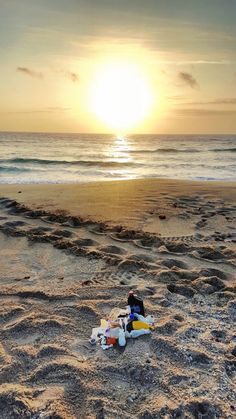
In early 2017, in a partnership among the FWC, the National Oceanic
and Atmospheric Administration’s (NOAA) Marine Debris Program, the Florida
Department of Environmental Protection (FDEP), and numerous other statewide
agencies and organizations, the Florida
Marine Debris Reduction Guidance Plan (FMDRGP
or Plan) was completed.
Marine debris is a global issue and one of the most
widespread problems facing the marine environment, wildlife and habitats today.
In Florida, marine debris originates from land-based and other local sources,
but some is washed in by ocean currents, gyres and severe storms from other
parts of the Caribbean world, including Central America, South America and even
Western and Equatorial Africa. Similarly, debris originating from Florida
travels across the Atlantic to other parts of the world as well. Florida is
nationally recognized for its coastal and marine resources, and these resources
are increasingly harmed or degraded by marine debris.
There was a need to identify and prioritize
marine debris issues to address both everyday marine debris and debris
generated by severe weather. There is broad recognition that the amount of
marine debris is increasing, and the sources and effects of marine debris on
natural resources is beyond the capacity of any single government, private or
public organization. The core purpose of the development of the FMDRGP was to provide people working on
marine debris in the State with a common set of goals and strategies to work
cooperatively to manage the problem at a statewide level as well as establish
and/or strengthen international partnerships.
|
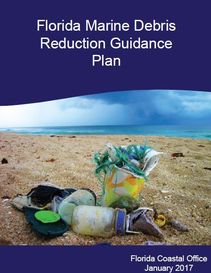
The FMDRGP is the
result of a four year process supported both financially and with personnel
from the NOAA Marine Debris Program. FDEP took the lead on the drafting of the Plan using the information
generated from these annual meetings and provided by subject matter
experts. FWC Divisions of Habitat and Species Conservation (HSC), Marine
Fisheries Management (MFM), Law Enforcement (LE) and the Fish and Wildlife
Research Institute (FWRI) have leadership roles in four of the five Working
Groups, and 23 FWC staff have
participated in workshops and the development of the Plan’s goals and objectives. The FMDRGP development had considerable participation by government and
nongovernment organizations. Eighty-two people from 14 government organizations
and 24 people from 14 nongovernment organizations participated in the Plan development.
The Plan introduces
5 Goals (and associated Working Groups) which encompass key resource concerns
of the FWC and/or sources of particular environmental risk. (Chapter 4):
• Goal 1 – Reduce the amount of
Consumer Debris
• Goal 2 – Reduce the amount of
Derelict Fishing Gear
• Goal 3 – Reduce the amount of
Abandoned and Derelict Vessels
• Goal 4 – Increase the capacity to
respond to Emergency Debris
• Goal 5 –
Reduce the impact of marine debris on Wildlife and Habitats
Goal 1 – Reduce the
amount of Consumer Debris reflects what is commonly considered to be the
most important first step in all waste management endeavors – reduce the amount
of material that can become debris. Consumer debris is not only an eyesore,
fouling economically and environmentally important beaches and other marine
areas frequented by people living in and visiting Florida, but is also a threat
to many listed species in Florida that accidentally ingest the debris,
mistaking it for common food sources found in the marine environment.
Stakeholder engagement to address the strategies outlined in this Goal are
essential to address the most common causes and sources of consumer debris.
Goal
2 – Reduce the amount of Derelict Fishing Gear identifies fishing gear that is generally
abandoned, lost or discarded resulting in, where surveyed, a significant source
of submerged debris in Florida. Derelict fishing gear not only creates an
entanglement and/or ingestion hazard for wildlife, but also causes damage to
benthic marine habitats, such as seagrass beds, coral reefs and mangroves that
support healthy and sustainable fish and wildlife populations. Derelict gear
can also pose a human safety risk, particularly to boaters and scuba divers.
This Goal relies on better partnerships, education and research into better
technology to reduce this type of debris.
|
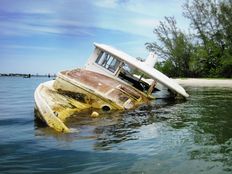
Goal 3 – Reduce the amount of
Abandoned and Derelict Vessels includes several objectives that emphasize
use of partnerships and education to essentially promote the need for more
effective ways to prevent vessel abandonment or promote and allow effective
derelict vessel disposal. Abandoned and derelict vessels can result in both
environmental and navigational hazards.
Florida has recently made considerable progress that allows more timely
interventions to prevent vessels that are likely to become derelict from
impacting the environment or public safety.
Goal 4 – Increase the
capacity to respond to Emergency Debris addresses a gap in both the area of
responsibility and the funding mechanism to respond to isolated events which
pose an imminent threat to humans or wildlife from marine debris. Many of the
strategies of this goal address the designation of authority to allow action
outside of the normal role of an agency. For this Plan, emergency debris was divided into two categories to most
effectively address this goal, resulting in the Marine Debris Rapid Response Program
(MDRRP) and the Disaster Debris Program (DDP). As outlined in the FMDRGP, the MDRRP “responds to marine
debris of unknown origins that poses an imminent threat to human health and
safety and/or natural resources that is not covered under another existing
marine debris program.” DDP “strives to coordinate a response to debris
resulting from a catastrophic event.”
Goal 5 – Reduce the
Impact of marine debris on Wildlife and Habitats reflects a core principle
of the FWC. As such, this Goal is overarching in nature, given its significant
interaction with Goals 1-4, and represents the successful outcome of the other
four Goals. The focus of this Goal is to minimize the impacts of marine debris
on wildlife and habitats by increasing the understanding of their interactions
through better and more comprehensive data monitoring and assessment,
developing protocols for removal of debris from sensitive habitats,
strengthening response to wildlife entanglements and/or ingestion and expanding
scientific research. One such program
that targets wildlife and habitat impacts is the Monofilament Recovery and
Recycling Program (MRRP) managed by the FWC (http://mrrp.myfwc.com/).
See the Staff Spotlight Section for more information on Elizabeth (‘Lizzie’)
Winchester, MRRP Statewide Coordinator.
These Goals are specific to Florida but are consistent with
the broader, global marine debris prevention and management issues identified
by the internationally recognized Honolulu
Strategy. The FMDRGP is intended
to serve as a tool for aiding in the development of future agency and
organizational conservation work plans and provide guidance and prioritization
of research, management, outreach and conservation efforts. Intentionally, the FMDRGP does not assign actions or
prescriptive measures to any specific agency or organization. The FMDRGP is intended as a living document
and to serve as a guide to identify the key issues around the State. Strategies
associated with each goal emphasize organizational partnerships and education
and, as a living document, implementation planning is the next step in the plan
to continue moving the FMDRGP
forward. Agency coordinators from the FWC, NOAA and FDEP are currently working
together with the five Working Groups to coordinate and assist in the
development of an implementation plan and timeline.
Currently, a copy of the FMDRGP can be found at https://marinedebris.noaa.gov/florida-caribbean
and http://www.dep.state.fl.us/cmp/publications/FL_Marine_Debris_Reduction_Plan2017.pdf.
A copy of the Plan will also be
available soon on a new FWC Marine Debris page (in development) that will also
provide opportunities for commenting and feedback, marine debris reduction
resources, cleanup events and volunteer opportunities, links to related FWC
Programs and much, much more! Please contact MarineDebris@MyFWC.com for more
details or for marine debris related questions/comments.
Back to Top
|

Fireworks are a staple of summer celebrations, but both the
noise and the debris left behind by fireworks can be harmful to wildlife.
Fireworks tend to cause animals to panic in their efforts to flee the noise,
explosive lights and the associated crowds of people, potentially resulting in
stress, injury and even death. A review of studies concerning the impacts of noise
on wildlife found that wildlife behavior and individual fitness was affected,
ultimately resulting in changes to ecological communities.
“Fireworks launched too close or toward a nesting colony can
cause adult shorebirds to flush off their nests and chicks to scatter, leaving
the chicks vulnerable to predators, the elements and the potential of getting
accidentally stepped on by beach-goers,” said Nancy Douglass, who works on
shorebird conservation for the FWC.
In addition to the noise factor, fireworks leave behind
particulate matter that is a source of air pollution, and some firework litter may
cause physical damage to wildlife. Shorebirds, sea turtles and other coastal
wildlife may become entangled in or ingest debris. Errant fireworks can also
cause wildfires, damaging wildlife and habitats.
Even with these risks in mind, it is still possible to
safely enjoy fireworks by following some simple guidelines:
- Leave personal fireworks, including sparklers,
at home and attend an official fireworks display instead. Official displays
must obtain permits which have conditions to minimize the impacts on wildlife.
- If you see firework residue remaining on the
beach, pick it up and throw it away, preferably in a lidded trash can away from
the beach.
- If you choose to use your own fireworks, do not ignite
them near trees, dune vegetation, beach wrack, nesting areas, rookeries, brush
piles or other sheltered areas where wildlife may be living. Remember that the
only fireworks legal for personal use in Florida are sparklers, fountains,
snakes and glow worms—nothing that explodes, flies or lifts off.
- Follow all the proper fireworks safety tips to
keep friends and family members safe; many of these common sense safety tips
can also protect pets and nearby wildlife from unnecessary trauma or injuries
caused by fireworks.
- Spread the word about fireworks and report any
activities that disturb or harm wildlife to the FWC’s Wildlife Alert Hotline at
888-404-FWCC (3922), #FWC or *FWC on a cell phone, or by texting Tip@MyFWC.com.
Back to Top
|
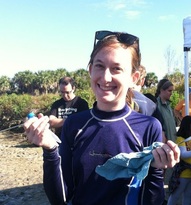
-
What is
your title? Education Specialist - Division of Marine Fisheries Management
-
What
organization do you work for? Florida Fish and Wildlife Conservation
Commission
-
What type
of work do you do? I run and coordinate a variety of outreach and education
programs for the state. I am the Kids’ Fishing Clinic Coordinator, so I travel
around to different cities in Florida putting on events to engage and teach
youth ages 5-15 about ethical angling, habitat conservation, basic fishing
techniques, as well as other marine resource information. I am also the state
coordinator for the Monofilament Recovery and Recycling Program (MRRP), which
means I am in communication with local coordinators all over the state to make
sure every location has the information and materials that they need to run a
successful program. We also promote cleanup events to make sure everyone knows
that they can play a part in keeping our oceans marine debris free! I am also
the primary aquarist for the Division of Marine Fisheries taking care of our
educational animals that we take to our outreach events.
-
What
project(s) have you recently been working on? One of my most recent
projects has been revamping our MRRP Facebook page – Facebook.com/FloridaMRRP –
check it out.
-
How does
your work relate to the CWCI? My work relates to CWCI because of the
education and outreach that I do. One of CWCI’s goal is to protect coastal
wildlife populations and to achieve a balance between conservation and
recreational activities, such as fishing. I reach out to future anglers and
teach them how to respect and conserve the coast and the species that inhabit
that environment.
-
How long
have you been working in the coastal environment, and what are some lessons you
have learned? Although I’ve always been a beach goer, my first marine
education internship was with an organization in the Keys in 2010, so I guess 7
years! I’ve learned how interconnected every part of the marine environment is
and everything you do during your daily life has an impact on our oceans.
-
What do
you think is the greatest threat to coastal ecosystems, and what action(s)
should be undertaken to address it? I think one of the greatest threats to
coastal ecosystems is single use plastics, such as plastic bottles, plastic
bags, and balloons that can last hundreds of years. These items are some of the
most commonly found items during beach cleanups and have the biggest effects on
marine life. There are simple actions that people can take to keep these items
off of our beaches: reusable water bottles, say no to straws, cloth bags when
shopping, and reusing and recycling when possible!
-
What is
your favorite coastal animal, and why? I love all species of sea turtles,
especially the loggerhead sea turtle. I am fascinated with their life history:
nesting on the same beach as they were born on and the eggs actually hatching.
Seeing the complete process of a female laying her eggs during a late night
turtle walk changed the way I looked at all things marine related.
-
Do you
have a message you would like to share with readers of this newsletter? You
can make a difference! I challenge you every time you go to the beach, pick up
and throw away (or recycle!) 5 pieces of trash and to challenge your friends
and family to do the same.
Back to Top
|
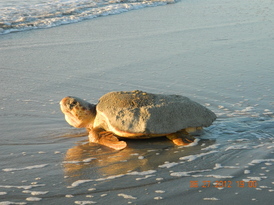
This summer’s Critter of the Quarter is the loggerhead sea
turtle (Caretta caretta), which is
the most abundant nesting sea turtle present in Florida. Loggerhead nesting and
hatching season runs from May 1 through October 31st in the state of
Florida, which is why this species was chosen for this quarter. The loggerhead
sea turtle can weigh around 400 pounds as an adult and has a hard shell called
a carapace. They are reddish brown in color and have a large head (which is
where the name “loggerhead” comes from) that has strong jaws for crushing their
prey (typically mollusks and crustaceans).
Loggerhead sea turtles are reptiles and must exit the ocean
to dig nests and deposit their eggs in the beach sand. The females then cover
their nests and camouflage them and return to the ocean. Their nests may be
subject to predation by raccoons, coyotes, foxes, ghost crabs and other
animals. After 45 to 60 days, the eggs hatch, and the hatchling turtles dig
their way up out of the sand together. At the surface, they orient towards the
brightest horizon, which should be the ocean. Once they make it to the water,
they have a “swimming frenzy” period that allows them to get out to the
sargassum weed in the oceanic gyres. There they spend the next several years
until they settle out as juveniles into neritic (nearshore) habitat. Once they
become adults, they will make the long migration to their natal beaches to
repeat the cycle.
Threats to these turtles include incidental capture from
fisheries, coastal development and marine debris. Artificial lights near
nesting beaches may draw turtles landward in a process we call
“disorientation”. Disoriented turtles are more likely to be caught by predators
or may die from exhaustion or dehydration. Those that eventually make it to the
water may be less fit for their offshore journey. Humans can modify their
lights on beachside buildings to prevent them from disorienting turtles. Other
threats to loggerheads include marine debris. Turtles can become tangled in
things like discarded fishing gear that could damage their flesh or even
prevent them from surfacing to breathe air. Some marine debris such as plastic
bags and released balloons may also resemble their food items, causing them to
ingest it and become ill or die. Properly disposing of debris and minimizing
the amount of plastic you consume are great ways to prevent this risk to
turtles. There is even a state law that regulates balloon releases for this
reason.
Back to Top
|
Ocean Conservancy’s International Coastal Cleanup –
This cleanup event will take place Saturday, September 16, 2017 and involves
local volunteers collecting trash and recording it on data cards. The map of
locations is on the website, and anyone can add a local cleanup to the map.
FWC’s Monofilament
Recovery and Recycling Program – Volunteer to empty a monofilament recycling
bin at regular intervals at a location near you, or help keep fishing line out
of the environment in other ways. For more information, contact Marine@myfwc.com.
FWC’s Kids’ Saltwater Fishing Clinics –
Host or volunteer at one of these educational events for kids ages 5-15 to create
responsible marine resource stewards, teach fundamental saltwater fishing
skills, and provide kids with a positive fishing experience. For more
information, contact Marine@myfwc.com.
Florida Shorebird Alliance –
Volunteer to conduct bird surveys, monitor beach-nesting birds and roof-top
nests, post sites, become a bird steward, or simply join a local partnership.
Sea turtle organizations – Many
organizations and individuals permitted by the FWC to conduct sea turtle
conservation activities use volunteers. To find out who may have local
volunteer opportunities involving sea turtles, contact MarineTurtleVolunteers@MyFWC.com.
FWC’s Horseshoe Crab Mating Survey – Volunteer to submit your observations of horseshoe crabs mating on
beaches into the Fish and Wildlife Research Institute’s online survey. For more information, contact horseshoe@MyFWC.com.
FWC’s Barotrauma Tool Study – Volunteer to take part in a descending-device citizen science study to test
a descending device and help identify the benefits and drawbacks of using this
tool when fishing in deeper waters. For more information, contact Marine@MyFWC.com.
FWRI’s Red Tide Offshore Monitoring Program – A volunteer program to assist the researchers
who study Karenia brevis, the
organism that causes Florida red tide. Citizen volunteers expand the spatial
coverage of FWRI's monitoring program by collecting water samples from routine
collection points and sites reported for suspected harmful algal blooms (HABs).
For more information, contact RTOMP_coordinator@MyFWC.com.
FWRI’s Bay Scallop Harvest Survey – Help biologists track the bay scallop population long term by
reporting data to a web
survey, such as where you harvest scallops, how many you
collect, and how long it takes to harvest them. For more information, contact BayScallops@MyFWC.com.
Back to Top
National Park Service
Rivers, Trails, and Conservation Assistance Program — This program assists with
community-led natural resource conservation and outdoor recreation initiatives.
RTCA staff provide guidance to communities so they can conserve waterways,
preserve open space, and develop trails and greenways. The Cycle 2 deadline is June 30, 2017.
Mohamed bin Zayed Species Conservation Fund — Grants of up to $25,000 will be
awarded in support of plant, animal, and fungi species conservation efforts for
endangered species, without discrimination on the basis of region or selected
species. The deadlines are three times a year: February 28, June 30, and October 31.
Mazda Foundation Grant Program — Awards may promote education and literacy,
environmental conservation, and scientific research, among other issues.
Applications primarily accepted from organizations located in markets where
Mazda has offices (Jacksonville, Florida). The deadline is July 1, 2017.
Woodard & Curran
Foundation 1 Year Grants – These address water
scarcity through STEAM (science, technology, engineering, art, and math). Projects
at levels of grant requests from $1,000 to $5,000 will be accepted. This
opportunity is limited to 501(c)(3) nonprofits. The deadline is July 1, 2017.
Woodard & Curran
Foundation 3 Year Impact Grant — Award of $100,000
funding an innovative project that applies or advances technology by addressing
water issues (e.g. water, wastewater, stormwater, etc.) relating to climate
change. This opportunity is limited to 501(c)(3) nonprofits. The letter of
intent is due July 1, 2017.
National Wildlife
Refuge Friends Request for Proposals — Competitive
grants ($1,500 – $15,000) go to creative and innovative proposals that seek to
increase the number and effectiveness of organizations interested in assisting
the Refuge System nationwide. The deadline is July 11, 2017.
U.S. Fish and Wildlife
Service North American Wetlands Conservation Act
Standard Grants — Public-private matching grants support long-term
protection, restoration and/or enhancement of wetlands and associated upland
habitats. U.S. Standard Grants Cycle 2 applications are due July 14, 2017. U.S. small grants
applications are due October 19, 2017.
National Fish and
Wildlife Foundation - Gulf Environmental Benefit Fund – Florida is
currently developing the GEBF Restoration Strategy, a science-based restoration
planning effort which will serve as a framework for the development and
implementation of GEBF projects to restore and conserve Gulf Coast natural
resources. There is a July 14th, 2017
deadline for new and updated projects to be submitted to the state project
portal to be reviewed for inclusion in the Restoration Strategy. For more
information see the NFWF-GEBF page at www.deepwaterhorizonflorida.com
or email Amy.Raker@MyFWC.com. Note:
The portal will remain open after this deadline – any submitted or updated
projects before or after this deadline will continue to be reviewed for all
Deepwater Horizon funding streams, as appropriate.
National Park Service
Land and Water Conservation Fund State and
Local Assistance Program — This provides matching grants to states and
local governments for the acquisition and development of lands and waters for
outdoor recreation purposes. Search grants.gov number P17AS00340. The deadline
is July 31, 2017.
Environmental
Protection Agency RESTORE Northwest Florida Estuary Program
— This notice announces the availability of funds and solicits proposals to
develop and stand-up a place-based estuary program encompassing one or more of
the following bays in Florida’s northwest panhandle region: Perdido Bay,
Pensacola Bay, Escambia Bay, Choctawhatchee Bay, St. Andrews Bay and
Apalachicola Bay. The deadline is August
1, 2017.
Environmental
Protection Agency Gulf of Mexico Program — This
notice announces the availability of funds and solicits proposals that address
water quality improvement; coastal habitat and ecosystems enhancement,
restoration and/or protection; environmental education and outreach; and
community resilience in the Gulf of Mexico region and its watersheds. The
deadline is August 4, 2017.
Wildlife Acoustics Scientific Product Grant
— Wildlife Acoustics has established a grant program to support
bioacoustics research efforts from chiropteran, avian, terrestrial, amphibious
and marine wildlife, to everything else in between. The deadline is August 15, 2017.
Alcoa Foundation Grant Program — Sustainability is a
major focus promoting 1) the prevention of and resilience to climate change and
2) the restoration and preservation of biodiversity. Grants are awarded on a
rolling basis.
George & Miriam
Martin Foundation Grants — The focus of the
foundation is river and watershed conservation. There are no deadlines.
Rockefeller Family Fund — Grant
making currently has an environment program focus on the challenges of climate
change with an emphasis on public education. Letters of inquiry (LOI) may be
submitted at any time.
Surdna Foundation Grantmaking — Grant making to nonprofit
organizations in the priority areas of Sustainable Environments, Strong Local
Economies and Thriving Cultures. Letters of inquiry (LOI) may be submitted at
any time.
Waitt Foundation Rapid Ocean Conservation
(ROC) Grants — This opportunity provides small grants with a quick
turnaround time for solutions to emerging conservation issues. The funding
cycle is open to new applications. Proposals are reviewed monthly on a rolling
basis, although some applications take additional time to evaluate.
Wells Fargo Environmental Grant Program
— Environmental grant program focuses on addressing local environmental
priorities in communities and providing support that fosters innovation to help
accelerate a “green” economy. One letter of inquiry per year per organization
is accepted.
Back to Top
|